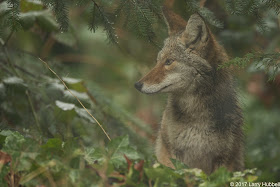In this shot, from just a moment earlier, another critical piece of information is revealed.
Zooming in on the male's left leg we see a purple band with the designation '1 over X'. The purple band indicates this bird is male. The code, containing the letter 'X', inspired me to think of this particular male as Excaliber.
Ed Deal and Martin Muller are local experts continuing a study of Seattle cooper's hawks. The study was originally started by Jack Bettesworth. From what I can tell, these gentlemen spend every available hour searching for and banding these birds. Earlier this month, the Raptor Research Foundation (RRF) published a brief summary of one of their recent articles detailing accounts of infidelity among cooper's hawks in Seattle. You can read the summary on the RRF Facebook page by Clicking Here.
This photo displays one of the many things I have learned from Martin. The male bird closes his fist-full-of-talons into a ball during mating to keep from harming the female. The female is willing to mate but apparently (and possibly instinctively) does not fully trust the male. If you look at the female's eye in this photo, compared with her eye in the first photo, it is obvious she has closed her nictitating membrane over her eye. These extra transparent 'eyelids' help protect her eyes from damage. I suspect they must reduce visibility to some degree since we can see the color of her iris looks somewhat hazy with the membrane extended.
Another piece of information which Martin pointed out is that after mating the male quickly moves away from the female. He said, 'The males are smaller than the females and the females eat small birds.' I do not know if anyone has ever seen a female eat her mate, but apparently the male does not care to tempt fate.
The two genders have very specific roles. The female lays the eggs and spends a great deal of time brooding. From what I have seen the male does the majority of the nest building and supplies most of the food for the brooding female and the young birds once they hatch.
Within a minute after mating, the female begins to feed...
...on the carcass of a small bird.
While I did not catch the event, I suspect the male caught the bird and brought it to the female just prior to mating. Food deliveries help to prove that the male is capable of supporting the female and their future progeny. No doubt the food also supplies calories and energy critical to the development of the eggs.
This photo, from the next day, may be the only photo in which I capture all four young birds at one time.
I find the bright white colors of the young birds beautiful and surprising. How do these young creatures benefit from wearing such bright attention-grabbing attire - especially since they cannot fly to escape danger.
Here the adult is feeding one of the young. Can you tell which adult we are looking at? I am honestly not positive, but the brown coloring of the bird's back and wings, instead of grey-blue, makes me think this is the female. Plus, there is the fact that the females spend more time around the nest while the males are out hunting.
Last Spring, just before the young birds fledged, I remember watching them run back and forth across the nest. Their fast movements and sudden stops certainly scared me - but did not seem to bother them at all. Their agility reminded me of the predatory speed of velociraptors as depicted in movies.
The males wear the purple bands on their left legs while the females wear orange bands on their right legs. As Ed says, 'The females are always right.' It would certainly be wonderful to find out if Excalibur (1/X) has survived the winter. Last year, there was another male I saw often around Union Bay. His code is O/Z, so I call him Ozzy. I am especially curious to hear about the fate of both Ozzy and Excalibur.
My email address is: ldhubbell@comcast.net.
I am equally interested in the females - but last year the mates of both of these birds were too smart to wear attention-grabbing jewelry.
Have a great day on Union Bay...where nature lives in the city!
Larry
Going Native:
Without a functional Environmental Protection Agency, it falls to each of us to be ever more vigilant in protecting our local environments. Native plants and trees encourage the largest diversity of lifeforms because of their long intertwined history with local, native creatures. I have been told that even the microbes in the soil are native to each local landscape. My hope is that we can inspire ourselves, our neighbors and local businesses to plant native flora and to support native wildlife at every opportunity. My intention is to include at least one photo each week and visually challenge us to know the difference between native and non-native lifeforms.
Which of the following plants are native to Union Bay?
A)
Both species are native to the Union Bay and they are both flowering now - however their scents are decidedly different. I was surprised to learn that Skunk Cabbage is also called Swamp Lantern.A)
B)
************
Scroll down for answers
*************
Species highlighted in green are native to Union Bay.






































































